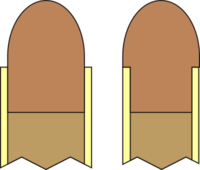Heeled bullet

A heeled bullet is an archaic design of bullet where the internal diameter of the barrel is the same diameter as the cartridge case, and the bullet has a step at the rear to allow it to fit inside the case. Heeled bullets mostly disappeared with the advent of smokeless powder cartridges, though older rimfire designs, such as the .22 caliber rimfire cartridges, still use heeled bullets, and many cartridges that date back to the black powder era still reflect their heeled bullet origins in their caliber designations.
Reasons for change
The heeled bullet design has some advantages, mainly when coupled with the straight-walled cases it appeared in. Converting a cap and ball revolver to use cartridges was as simple as cutting off part of the rear of the cylinder, replacing it with a frame-mounted ring, and changing the hammer. It also made new revolvers easier and cheaper to manufacture as the chambers could simply be drilled straight through the cylinder, whereas bullets narrower than the case required two different diameters to be drilled, and careful control of the depth for the larger diameter bit. Finally, it made it very easy to chamber cartridges of the same diameter but differing lengths in the same firearm, which is still commonly seen today in .22 caliber rimfire firearms, which are marked ".22 Short, Long, and Long Rifle". While this can be done with straight-walled cases not using heeled bullets, such as .38 Special in .357 Magnum firearms, it tends to create a lead and powder residue buildup at the front of the chamber, which can cause reliability problems if not cleaned out before switching back to the longer case.
One of the primary reasons for the change was the issue of lubrication. Lead bullets, especially soft, low alloy lead used in low pressure cartridges, need to be lubricated to prevent lead buildup in the bore. This lubricant can be applied either to the exposed portion of the heeled bullet, called outside lubricated, or on the portion inside the case, called inside lubricated. Outside lubrication requires a hard, dry lubricant, as anything soft or sticky will rub off or pick up dirt that comes in contact. Inside lubrication, on the other hand, can use sticky wax or grease, but then needs some means for the lubricant to reach the wall of the bore, since the diameter of the heel is smaller than the bore. While there were some methods patented to allow inside lubrication of heeled bullets (such as a piston at the base, which forces lubricant out ports in the exposed sides of the bullet upon firing), they never became popular, due to the complexity and expense involved. Non-heeled bullets, however, can easily be lubricated on the portion inside the case using a grease groove packed with lubricant. This prevents the lubricant, usually a grease or wax, from picking up dirt and grit which can damage the bore.
Surviving examples
Arguably, heeled bullets are still very common because, while very few calibers use them, the .22 Long Rifle does, and it is the most commonly used cartridge in the world. The other cartridges in the .22 Long Rifle family, the .22 Short, .22 Long, .22 CB and .22 BB, all use heeled bullets. A few other heeled-bullet cartridges are available, but they all originated in the late 19th century. The recent gains in popularity of Cowboy Action Shooting has increased interest in these old cartridges, and there are even a few new replica firearms being made to chamber them.
Cartridges evolved from heeled bullet designs
To convert a heeled-bullet cartridge to a non-heeled design, it was necessary to either enlarge the case diameter, or shrink the bullet and bore diameter. Examples of both choices can be found, but some of the more evident and confusing examples are cases where the bullet diameter was reduced. Many shooters wonder why a .38 caliber firearm actually shoots bullets of diameter .357 inches, and a .44 caliber firearm shoots .429-inch-diameter (10.9 mm) bullets. In both of these cases, the name of the caliber derives from older heeled-bullet designs, and the name was kept even when the bullet was shrunk to fit inside the case. The .38 S&W cartridge, for example, dates from 1877 and has a nominal outside case diameter of .380 inches, while the inside of the case is .357 inches. Older .38 caliber cartridges, like the .38 Short Colt, did use a heeled bullet, so rather than create a new ".35" or ".36 caliber", Smith & Wesson kept the designation ".38" even though it no longer accurately reflected the groove diameter. The later .38 Special continued the trend, and even automatic pistol cartridges like the .38 Super and .380 ACP retained the .38 caliber designation, even though they were .357s. This continued until 1935 and the introduction of the .38 Special-based .357 Magnum cartridge. The newer (1956) .44 Magnum, however, retained the designation of its parent .44 Special cartridge, even though it fired a .429 inch bullet. The legacy of heeled bullets is the cause of confusion among many shooting enthusiasts over the actual physical diameters of the bullets they fire in their guns.